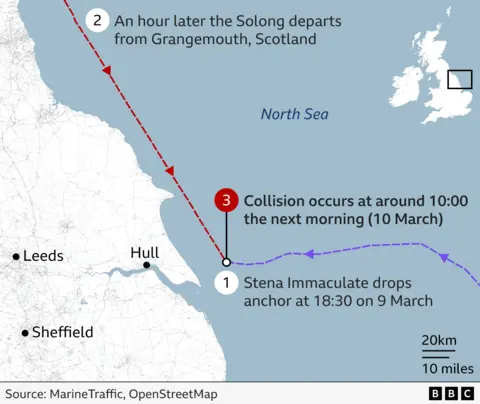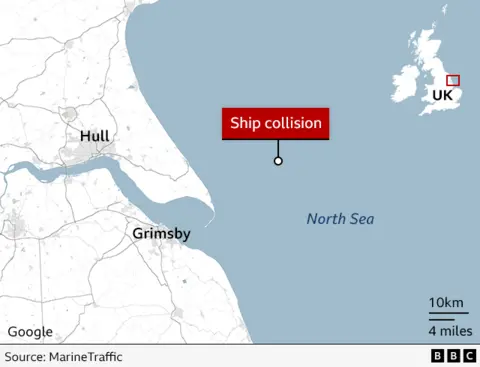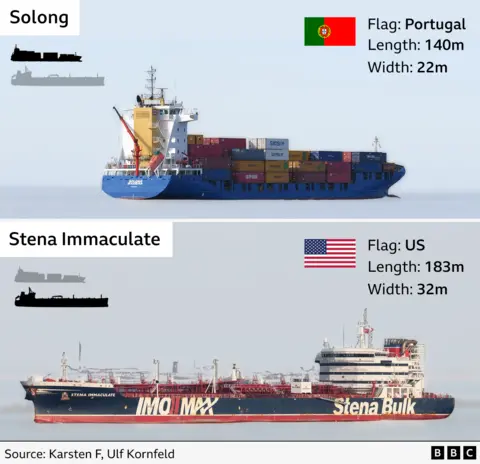North Sea tanker collision - what we know so far
One crew member is missing, presumed dead, while more than 30 people have been rescued after a cargo ship, the Solong, struck an oil tanker, the Stena Immaculate, in the North Sea off the east coast of England on Monday.
It is unclear how much fuel has been released into the sea, but early assessments suggest the impact is limited, with some fuel having burned off and evaporated.
The Solong was still on fire on Wednesday, while the fire on the Stena Immaculate has been extinguished, according to the ship's co-owner. Despite initial fears of potentially devastating environmental damage, air quality tests have registered no toxins so far.
A 59-year-old Russian national - who, according to the Solong's owners, is the ship's captain - was arrested on suspicion of gross negligence manslaughter on Tuesday.
How did the crash happen?
The Portuguese-flagged Solong struck the larger oil tanker in waters off Hull just before 10:00 on Monday.
The Stena Immaculate had been anchored there after making its way to Hull from a Greek port. The US-flagged ship had been transporting jet fuel for the US military.
The Solong container ship had been making its way south to the Netherlands from Grangemouth in Scotland.
An American sailor from the Stena Immaculate described the point of collision to the BBC's US partner CBS.
He said "a massive ship came from out of the blue" and those on board only had seconds to react. He did not give his name as crew are not currently allowed to speak to the media.
The sailor said flames immediately began erupting from the vessel following the crash.
One of the men who was on the Stena Immaculate told the BBC the Solong collided with the anchored Stena Immaculate at 16 knots (around 18mph).
Data from tracking site MarineTraffic appears to indicate that one ship was moving and the other was nearly stationary when the collision happened.

It is still unclear what caused the cargo ship to strike the oil tanker.
Martyn Boyers, the chief executive of the port of Grimsby East, told Sky News the area had been "very foggy" on Monday morning, which may have contributed to visibility issues.
Meanwhile a rescuer told The Times the fog was so thick during the initial search that crews could "not see a thing".
What is the current situation?
As of Wednesday afternoon, fire on the Solong has diminished but continues to emit smoke with occasional reports of flames, according to its owner Ernst Russ.
It said the Solong has separated from the Stena Immaculate and has drifted south as marine firefighting crafts tackle the blaze.
The fire onboard the Stena Immaculate had been extinguished as of Wednesday afternoon, according to its co-owner Stena Bulk.
It is currently safe at anchor, and over the next few days the owners will decide what to do with the ship, it added.
The Maritime and Coastguard Agency (MCA) said there have been no further reports of pollution from either vessel.
The UK's transport secretary has said the Maritime Accident Investigation Branch has begun a preliminary assessment of the crash, and that early indications suggested both vessels were not expected to sink.
Earlier, an exclusion zone of 1km radius was put in place around both vessels.
What about the crew?
One of the 14 Solong crew members is still missing and presumed dead, with the search called off on Monday night after "an extensive search", said the coastguard. They have not yet been identified.
Whitehall sources have told BBC News there were Russians and Filipinos among the Solong's crew.
Ernst Russ, the German owners of the Solong, said their "first thoughts" were with the family of the missing crew member "at this uncertain and distressing time".
They confirmed the captain of the ship had been arrested and said that he, along with the rest of the crew, were assisting the investigation.
Humberside Police's senior investigating officer Detective Chief Supt Craig Nicholson said specialist officers have been tasked with making contact with the missing sailor's family and supporting them.
It is thought that all 23 crew on board the Stenna Immaculate were Americans who are currently in Grimsby and are likely to be repatriated in due course.
The entire crew managed to evacuate safely during the disaster.
The Stena sailor said after the Solong crashed into them, the crew on board the tanker had tried to fight the fires, but they realised it was futile - so they made the decision to abandon ship.
Crew members grabbed their essential belongings from their cabins - and after everyone was accounted for- boarded the lifeboat together.
Their captain was the last person to leave the ship, the sailor said. He described flames licking at the crew as they headed for the lifeboats. Some even had their hair singed.
The whole process took about 30 minutes, he told CBS.
A total of 36 crew members from both vessels were brought back to shore. One person was taken to hospital.
Where did it take place?
The collision took place about 13 miles (20km) off the East Yorkshire coast, near Hull and Grimsby, in a busy shipping area.

The Stena Immaculate was anchored and drifting at a speed of 0.1 knots at 09:48 GMT on Monday, according to ship tracking site MarineTraffic.
The tanker had been anchored there since Sunday evening, while the Solong had been approaching from the north after setting off from Grangemouth in Scotland on the same night.
What do we know about the ships and what were they carrying?
The vessels are the oil tanker MV Stena Immaculate and a cargo ship called Solong. Here is a graphic to show how they compare:

The Stena Immaculate is a US-flagged ship that was transporting jet fuel for the US military.
Crowley, the firm which manages the ship, said it was unclear how much fuel might have been released but the tanker had been carrying 220,000 barrels of jet fuel when it was struck.
Erik Hanel, who runs the ship's co-owner Swedish firm Stena Bulk, said the jet fuel was spread among 18 containers and either one or two have been damaged.

The Solong had been making its way south from the Scottish port of Grangemouth to Rotterdam in the Netherlands.
Operator Ernst Russ said on Tuesday the ship had not been carrying containers of sodium cyanide - which had been previously reported.
What is the environmental risk?
The Stena Immaculate's owner confirmed at least one fuel tank had ruptured on the tanker. But it's unknown how much jet fuel has entered the water.
Jet fuel is toxic and if ingested can kill marine organisms, which can then become harmful to seabirds that feed on them.
Some of the fuel has been burnt off, but jet fuel has a high boiling point, so evaporates slowly.
Crowley said an initial review showed impacts on the sea had been "limited due to exposure to the fire and evaporation" of the fuel.
They did not say that the fire on board had been put out.
Experts say the extent of the risk will depend on how much fuel has leaked out and the speed at which authorities contain the spill. It also depends on natural conditions, such as how quickly bacteria can break down the liquid.
Local wildlife trusts have warned of a potentially "devastating" impact on local habitats and species including threatened seabird colonies, grey seals, harbour porpoises, fish and minke whales.
Solong's owners said they had a team "actively engaged" with local authorities and would work with clean-up teams to "mitigate further impacts on the marine environment".
Chief Coastguard Paddy O'Callaghan said in a statement on Wednesday evening that aerial surveillance flights "have not indicated any pollution on the surface of the water attributable to either of the casualty vessels".
What could be done?
The clean-up needs to start "as quickly as possible", said Dr Paul Johnson at the University of Exeter's Greenpeace laboratories.
He told the BBC it would be "very difficult, very time consuming" and require "considerable investment in heavy equipment".
The operation is still focused on containment of the ships. But animal charities have said they are on standby to treat any injured birds and marine life that wash ashore.
The UK is responsible for responding to marine pollution up to 200 nautical miles from land, with a specialist coastguard team expected to lead the effort.
After finding the source of the spill, teams will work to stop the fuel from spreading using a variety of methods.
Options include deploying inflatable tubes called booms, which are hundreds of metres in length and laid on the water's surface to stop the oil from spreading.
Teams could also use mechanical devices called skimmers, which are designed to float on the surface and pump contained oil into waste storage units.
Chemical dispersion could also be used. This involves spraying a specially formulated dispersant from modified aircraft or boats which breaks the oil into smaller droplets that sink.
